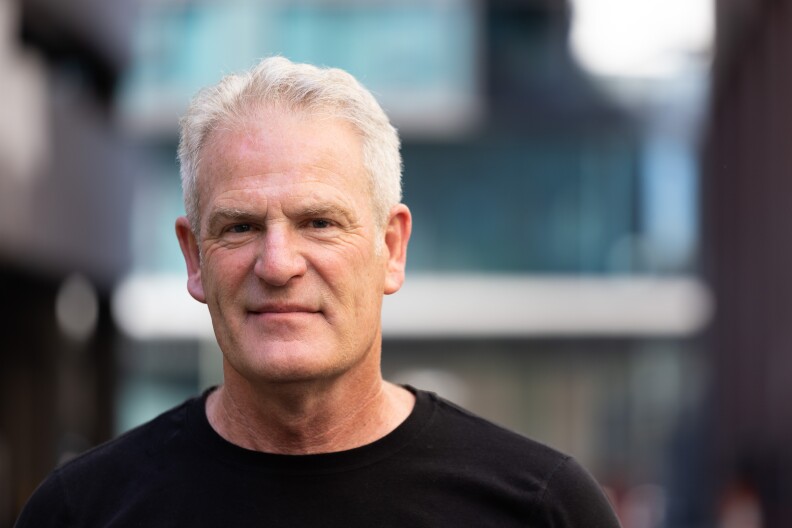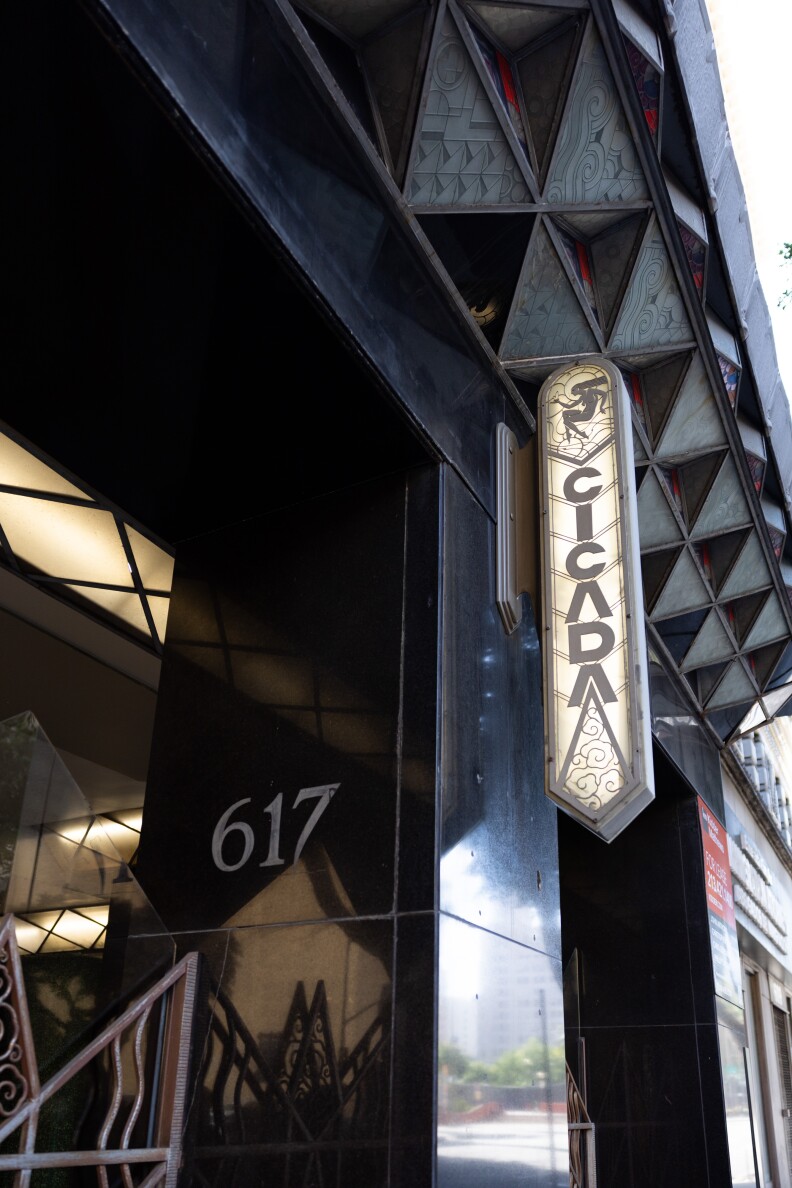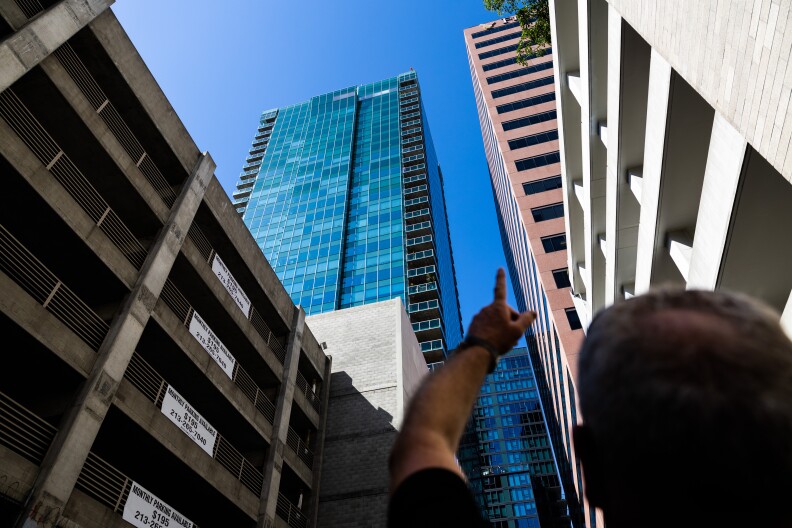Why LA Makes A Great Stand-In For So Many Other Cities In TV And Film

We know L.A. is L.A., but it’s also sometimes Chicago, San Francisco, New York, and probably any city you can imagine — at least in the movies.
As a Los Angeles-based film location scout/manager who’s been in the business for nearly 30 years, Rick Schuler has found lots of streets and buildings in downtown L.A. that can look like lots of other places.
L.A. of today can also transform into different time periods too — like 1960s-era Los Angeles (for the 2019 film “Once Upon a Time in Hollywood”) , and L.A. in the “near future” (for the 2013 film “Her”).
-
At magnitude 7.2, buildings collapsed
-
Now spinning in front of Santa Monica apartments
-
Advocates seek end to new LAUSD location policy
Schuler’s other film credits include “Seven” (1995), “Mr. and Mrs. Smith” (2005), “A Star Is Born” (2018), and “Once Upon A Time In Hollywood” (2019). All of them were filmed, at least partially, in and around L.A.
Maybe more than other cities, Schuler says, “L.A.’s very adaptable to pass as a lot of different places.” Why? Part of it has to do with the variety of architecture in Los Angeles, and even just in downtown L.A.

Schuler recently took the How To LA team at LAist on a tour of downtown L.A. to share how he goes about finding filming locations in Los Angeles, and how many of them can pass for other places.
Los Angeles in disguise
Schuler has used the art-deco-style Oviatt Building near Pershing Square, built in 1928, for a variety of non-Los Angeles locations.
“There's art deco throughout L.A.,” Schuler says. “But it's disappearing little by little.”


In Quentin Tarantino’s “Once Upon a Time in Hollywood,” which is almost entirely set (and filmed) in L.A., the Oviatt's covered, partially outdoor lobby, with columns that are lit from within, served as the filming location for the scene where Leonardo DiCaprio’s character was meant to be at an outdoor Italian cafe.
The interior of the building, which is now a restaurant called Cicada, was used as a stand-in for New York in “Mr. and Mrs. Smith.”
“This feels [like] New York,” Schuler told How To LA host Brian De Los Santos. “And we wanted something that was grand, we wanted something that was opulent, we wanted space.”
In the scene, Brad Pitt and Angelina Jolie’s characters are dancing, so the fact that it had a dance floor already there was helpful, Schuler says: “The height gives us room to light, and the reflective nature of what's in here also helps and sort of creates a mood.”
Los Angeles as itself, but different
The Watermarke Tower at 705 West 9th Street was used in the 2013 movie “Her,” directed by Spike Jonze. The film is set in a Los Angeles of the not-too-distant future (the exact date isn’t specified in the film, but it's likely some time between 2033-2043).
Schuler says he roughly divides downtown “between the more modern part of it, that would be sort of west of Hill Street, and then everything east of Hill gets into older [buildings], it's Broadway, it's Spring, it's Main Street, and that can play for New York, can play for Chicago, can play for parts of San Francisco.”

The Watermarke is a 35-story glass high-rise apartment building, with floor-to-ceiling greenish glass, and was used for both indoor and outdoor shots of actor Joaquin Phoenix’s character’s apartment. And back in 2013, Schuler says it was one of the few “newer” looking buildings downtown.
Because the film is set in the future, Schuler says, “at first I thought ‘Oh, I'm gonna need to find all these super modern buildings and everything’ and then realized that, OK, you know we're walking here and there's probably buildings that are a hundred years old right around us and we don't think like, ‘Oh, well that building shouldn't be there.’”
The DoubleTree Hotel near Little Tokyo was another filming location Schuler selected for “Her.” Originally called The New Otani Hotel and Garden, built in 1977, the hotel features a rooftop garden with fountains.
“What we had decided to do,” Schuler says, “both from an aesthetic and a production reason, was to elevate everything that happened. So they live up in apartments, they walk on bridges between buildings, and this was a place that was a garden that was above ground, too.”
How he ended up finding this location, which is somewhat hidden away, Schuler says gets at one of the basic things about the job of a location scout:
“That's the part of the job I like is that it's basically hitting the pavement. I mean, you gotta do the work. So, whether it's for this movie or another movie… you just go exploring.”
Back when he was new to Los Angeles, in the 80s, Schuler says he’d go driving around for 10 or 12 hours a day. Though downtown wasn’t too tough to figure out, he says. “Back then, L. A., downtown, stayed the same. So once you learned it, you kind of knew it. There wasn’t this boom in construction” that's been going on in recent years.
And before cell phones or Google maps, he’d be armed with only the Thomas Guide and pay phones.
But that was also the fun, Schuler says: “Just driving around and exploring and seeing what you could come up with."
-
Known for its elaborate light displays, this year, the neighborhood is expecting a bigger crowd tied to the release of “Candy Cane Lane” on Amazon Prime Video.
-
Dancers at Star Garden demanded better working conditions — including protection from aggressive guests. Up next: An actual contract.
-
The Alliance of Motion Picture and Television Producers rejected the SAG-AFTRA union's request for a separate type of residual payment that actors would get once their programs hit streaming services.
-
Sarah Ramos says she actually likes self-taped auditions, but without regulations: “This is a strain on our resources, a strain on our community and it's untenable.”
-
On the 50th anniversary of Lee’s death, a look back at the icon’s pre-fame years in L.A., in pictures.
-
Actor Erik Passoja said his digital likeness was used in a video game without his consent.










